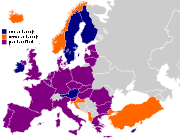
Berlin Plus agreement
Encyclopedia

1999 Washington summit
The 1999 Washington summit was the 15th NATO summit and was held in Washington, D.C. on April 24-25, 1999.Held at the height of the NATO bombing of Yugoslavia, the summit commemorated the fiftieth anniversary of NATO and reiterated the "determination to put an end to the repressive actions" by...
, sometimes referred to as the CJTF mechanism, and allowed the EU to draw on some of NATO's military assets in its own peacekeeping operations.
Content
The Berlin Plus agreement has seven major parts:- The NATO-EU Security Agreement, which covers the exchange of classified information under reciprocal security protection rules.
- Assured Access to NATO planning capabilities for EU-led Crisis Management Operations (CMO).
- Availability of NATO assets and capabilities for EU-led CMOs, such as communication units and headquarters.
- Procedures for Release, Monitoring, Return and Recall of NATO Assets and Capabilities.
- Terms Of Reference for DSACEUR and European Command Options for NATO.
- Arrangements for coherent and mutually reinforcing capability requirements, in particular the incorporation within NATO's defence planning of the military needs and capabilities that may be required for EU-led military operations.
- EU - NATO consultation arrangements in the context of an EU-led CMO making use of NATO assets and capabilities.
This comprehensive framework for NATO-EU relations was concluded on March 17, 2003 by the exchange of letters by High Representative Javier Solana
Javier Solana
Francisco Javier Solana de Madariaga, KOGF is a Spanish physicist and Socialist politician. After serving in the Spanish government under Felipe González and Secretary General of NATO , he was appointed the European Union's High Representative for Common Foreign and Security Policy, Secretary...
and the then-Secretary General of NATO
Secretary General of NATO
The Secretary General of the North Atlantic Treaty Organisation is the chairman of the North Atlantic Council, the supreme decision-making organisation of the defence alliance. The Secretary-General also serves as the leader of the organisation's staff and as its chief spokesman...
Lord Robertson
Lord Robertson
Lord Robertson may refer to:*James Robertson, Baron Robertson *George Robertson, Baron Robertson of Port Ellen *Ian Robertson, Lord Robertson TD, Senator of the College of Justice in Scotland, 1966-1987, chairman of the Merchiston Board of governors, 1970-1996...
.
Procedures
- The use of NATO assets by the EU is subject to a "right of first refusal" : NATO must first decline to intervene in a given crisis.
- Approval of the use of assets has to be unanimous among NATO states. For example, Turkish reservations about Operation Concordia using NATO assets delayed its deployment by more than five months.
Operations
To date, the EU has conducted two operations with the support of NATO:- Operation Concordia in the Former Yugoslav Republic of Macedonia. The EU took over from NATO's operation Allied Harmony and deployed around 300 troops to provide security to EU and OSCE monitors overseeing the implementation of the Ohrid Framework AgreementOhrid AgreementThe Ohrid Framework Agreement was the peace deal signed by the government of the Republic of Macedonia and ethnic Albanian representatives on August 13, 2001...
. - EUFOR AltheaEUFOR AltheaEuropean Union Force Althea is a military deployment in Bosnia and Herzegovina to oversee the military implementation of the Dayton Agreement. It is the successor to NATO's SFOR and IFOR. The transition from SFOR to EUFOR was largely a change of name and commanders: 80% of the troops remained in...
in Bosnia and Herzegovina. Following NATO's decision at the 2004 Istanbul summit2004 Istanbul summitThe 2004 Istanbul summit was held in Istanbul, Turkey from June 28 to June 29, 2004. It was the 17th NATO summit in which NATO's Heads of State and Governments met to make formal decisions about security topics...
to terminate the mission of NATO's Stabilisation ForceSFORThe Stabilisation Force was a NATO-led multinational peacekeeping force in Bosnia and Herzegovina which was tasked with upholding the Dayton Agreement. It replaced the previous force IFOR...
(SFOR) by the end of the year, the EU started its own 7,000-strong mission, EUFOR AltheaEUFOR AltheaEuropean Union Force Althea is a military deployment in Bosnia and Herzegovina to oversee the military implementation of the Dayton Agreement. It is the successor to NATO's SFOR and IFOR. The transition from SFOR to EUFOR was largely a change of name and commanders: 80% of the troops remained in...
, in the country with the aim to implement the military aspects of the Dayton Peace Agreement and to maintain a safe and secure environment.

